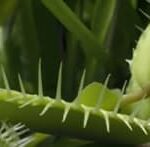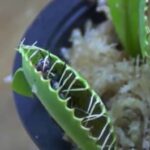As an Amazon Associate, this site earns commissions from qualifying purchases. For more details, click here.
Because Venus flytraps grow in savannas and bogs, we know it needs a lot of water. But how much is too much? Is it really possible to overwater Venus flytraps or not? Too much or too little water can make or break the plant so you have to take the proper approach here.
Venus flytrap pots should be placed on a tray with an inch of water, and the tray should be refilled as soon as it dries. Keep the soil damp but not too wet because root rot could set in and infect the plant.
How Much Water Does My Venus Flytrap Need?
Do not water the plant too much, just enough to keep the soil damp. Use only reverse osmosis, rain or distilled water because other sources may be harmful to the plant. This applies to other carnivorous plants as well.
Venus flytraps should be watered every two to four days. The soil must be kept moist at all times. Water the soil the moment it starts to dry.
Venus flytraps need plenty of water during their growing phase and the summer season. Keep at eye on the soil and make sure that it is constantly moist, but not drenched.
If the soil is moist when you touch it, you have done it right. If there is actual water, you have added too much. If the soil is dry, you have poured too little. We suggest using XLUX Soil Moisture Meter to accurately measure the moistness.
How to Water Venus Flytraps the Easy Way
The tray method is the easiest way to water Venus flytraps. Note: do not water the plant from the top if you will use this approach. Do not use this method when the Venus flytrap is dormant.
Here are the steps.
Place your Venus flytrap in a container with drainage holes. Even a plastic container will do. Our choice is Truedays Saucers as it is ideal for Venus flytraps.
Place the container on a tray.
Fill the tray with distilled, pure or reverse osmosis water up to 1/3 or 1 inch.
Refill the tray with water once it dries up.
This method is ideal for most because it is straightforward. You do not have to worry whether your Venus flytrap is getting too much or too little water.
The tray method works for growing Venus flytraps and when they are reproducing. The refill frequency depends on the season. During summer expect the plant to soak up the water quickly, but other times it will need less.
With the tray approach, you just need to refill it. There is no need to wonder if you have to water every two or every four days.
Watering from the bottom is just as effective as watering from the top. In both cases it will reach the Venus flytrap and the plant will be able to use it properly.
How Often Should I Water Dormant Venus Flytraps?
Dormancy is essential for Venus flytraps to live and without it, the plant will not survive. You have to be careful about how you water to avoid complications.
Dormant Venus flytraps should be top watered once every 8-16 days. Keep the soil damp – not too wet – and do not let it dry. Do not allow standing water to remain in the pot to prevent fungal and bacterial infection.
A lot of Venus flytraps die during dormancy due to overwatering. When Venus flytraps go through this stage, it sheds off its leaves and looks like it is wilting.
It is easy to mistake this for dying so owners water the plant to “revive” it, which does more harm than good. Knowing the difference between a dormant and dying Venus flytrap is crucial to avoid mistakes like this.
The most important thing is to prevent the soil from drying. The plant is not dead, just dormant. Even in this stage it still requires water though not as much as before.
The watering frequency given here is not set in stone. Some dormant Venus flytraps will be fine with watering weekly, others every two weeks.
You can find out how much water your Venus flytrap needs by inspecting the soil. If it is moist, you are watering correctly. If it is dry, you need to add more. If it is drenched, you added too much.
What Does an Overwatered Venus Flytrap Look Like?
The most common signs of an overwatered Venus flytrap are fragile, soft leaves and a rotting rhizome. The traps might not close and the plant has a squishy feel to it.
You can also tell by examining the soil. It should be damp, not drenched in water. The weather plays a factor too. The higher the humidity, the less water Venus flytraps use. Keep in mind their leaves also absorb water.
The most obvious indicator though is the rhizome as it should be white and firm. If it is brownish to black and feels soft, root rot has begun.
By the time growers check the rhizome the rot has already spread though. A better way is to keep an eye on the amount of water used.
If you are using the tray method, keep the water level to an inch high for a 4 inch pot, or two inches for a 6 inch pot. These are not exact numbers. You will know how much water is needed by examining the soil. If it is too dry, increase the water level. If it is too wet, reduce the water level or use a taller pot.
The tray method is a good way to prevent overwatering because it is straightforward. You can easily tell if the plant has gotten too much water.
If you use the top water method, keep an eye on the leaves and soil. The leaves should have rich colors and the traps a nice red.
Even if you are new to Venus flytraps, it is easy to tell if too much water was used. If the plant looks like it is soaking, then you probably need to cut down a little.
What Happens if You Overwater a Venus Flytrap?
It takes a lot to overwater a Venus flytrap. Experiments show you can leave it immersed in water for a few days and it will not kill the plant. But doing this carries a lot of potential risks.
If you overwater a Venus flytrap, it becomes vulnerable to root rot, bacterial and fungal diseases. Once infection sets in, the plant will turn black, lose vitality and eventually die.
Venus flytraps need water for photosynthesis, which allows them to create their own food. Contrary to popular belief, Venus flytraps do not consume insects for food. They do so for nutrients needed to grow.
Water allows these nutrients to circulate in the plant. Too much of it however, leads to root rot. Excessive water causes the roots to turn mushy.
The rhizome (or bulb) goes from white to brown into black. This soon spreads all over the leaves and traps.
When root rot sets in, a Venus flytrap becomes vulnerable to other infections. A severe infection can kill the plant quickly. If the root rot has not spread throughout the plant, you can remove the infected part and repot the rest.
This is why the tray method is very effective. You can start with an inch of water and a 5-7 inch pot. If the soil gets too wet, just reduce the water.
No matter what stage of growth your Venus flytrap is in, always use the right type of water. Distilled is the best as it comes close to what Venus flytraps get when they grow in the wild. Never use tap water unless you are certain it does not contain any harsh minerals.
Conclusion
The good thing is that as shown here, you can easily avoid overwatering Venus flytraps. All it takes is the right approach and care. The proper combination of water, sunlight and nutrients will keep your Venus flytrap alive and well for many years.
Venus flytraps can handle a lot of water, much more so than most plants. But there is such a thing as overwatering and it can have serious consequences. By following the tips here you should be able to avoid that.

My fascination with carnivorous plants began many, many years ago with Venus Fly Traps. Now I am more than happy to impart what I know with other enthusiasts and those who are curious about meat eating plants.



